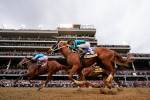Covered drinking vessel created to ward off illness
Tradition claims that it was the bubonic plague in the 14th century that inspired the creation of beer steins. Many people had noticed that there were more deaths in filthy places in town than in clean sections, and that there were clouds of insects along with the illness in Central Europe.
By the early 1500s, laws had been passed that all food and beverages served in public must be covered to keep insects away. The common drinking glass was a mug, so a hinged lid with a thumb-lift was added — and the stein was created.
Since beer was already a common beverage and its taste was improved when lids helped prevent spoilage, beer consumption increased and so did the manufacture of steins. They were made of pewter, wood, stoneware and, for the very wealthy, ivory. Painted or carved decorations were added.
A 1-liter stein made of carved ivory with scenes of cherubs drinking wine sold at a Fox stein auction in September 2014 for $5,760.
Q: I bought a Chinese lacquered cabinet from a friend who inherited it from her parents. Her father, a merchant seaman, bought the cabinet in Hong Kong years ago. It’s 35 inches tall and 41 inches wide. The top opens up like a chest, and both the inside of the top and the outside of the cabinet are painted and inset with jade. Is the chest valuable?
A: Your chest probably would sell for a good price. Chinese antiques are “hot” these days — sought by collectors here and in China. Lacquered cabinets are especially desirable and can sell for prices into the thousands, as long as they’re high quality and in great condition.
Q: I would like to know the value of a silver medicine spoon that belonged to my grandmother when she was a nurse at the turn of the 20th century. The handle curves back and turns under. There is a red cross on the back of the handle stamped, “Red Cross Medicine Spoon JB &SM Knowles, Prov., RI, USA.”
The gold-washed bowl ends in a pouring spout and is marked on the back “Pat. 1901, Sterling 925/1000.” What’s it worth?
A: Your medicine spoon, patented in 1901, was sold by druggists. The bent handle allows the spoon to rest level on a table so a teaspoon of medicine can be poured into it. J.B. &S.M. Knowles of Providence, R.I., was in business from 1875 until 1905. Your spoon is worth about $150.
Q: I have some Hess toy trucks from the 1960s and ’70s. I think Hess Corp. releases a new toy nearly every holiday season. Are mine worth much?
A: The first Hess toy truck, sold in 1964, was a tanker-trailer that would sell today for about $120. Others from the 1960s and early ’70s are even pricier. The 1970-’71 fire engine can sell for close to $500 if you have the original box, and the 1966 tanker ship with its box lists for well over $1,000.
Q: I have a Jim Beam decanter that’s shaped like a baseball. It’s 10 inches high, has a batter at the top and reads, “Professional Baseball’s 100th Anniversary, 1869-1969.” It has never been opened. What is it worth?
A: Jim Beam whiskey dates back to the late 1700s. The company started selling Kentucky Straight Bourbon in special containers in 1953. The bottles were made by Regal China Co. of Chicago, which made several series of collectible ceramic bottles.
Your bottle is from the Sports Series. Jim Beam ceramic bottles are not as popular as they were years ago and are not easy to sell. Your bottle, full or empty, in excellent condition might sell for $80. In poor condition, it’s worth $15 to $30.
Q: My father, born in 1889, worked as an electrician for the Sterling Bronze Co. of New York City. In 1916 he was working at a house in upstate New York, switching out a Sterling Bronze Co. six-light Colonial-style chandelier for a French Provincial model. He bought the Colonial model and left it to me in 1960. What do you think the chandelier would sell for today?
A: Sterling Bronze Co. was in business during the early decades of the 20th century. It made high-quality electric light fixtures, including chandeliers and sconces. We have seen pairs of Sterling Bronze Co. sconces auction recently for more than $2,000.
Chandeliers may not sell for as much, though, because it’s hard to find new light bulbs that work in antique fixtures. If you have bulbs for it that work and look attractive, ask a nearby appraiser to look at your chandelier in person to estimate its value.
Q: I would like to know if my picture titled “Ulysses and the Sirens” is of any value. It’s 7 by 10 inches and is signed by Thomas Moran.
A: Thomas Moran (1837-1926) was born in England but moved to Philadelphia with his family when he was a child. He worked as an illustrator in Philadelphia before moving to New York City, where he became a magazine illustrator and landscape painter.
His original landscape oil painting of “Ulysses and the Sirens” was completed in 1900 and is 28 by 40 inches. It sold at a 1999 Christie’s auction for $178,500. Your small print of the painting would probably sell for under $20.
Terry &Kim Kovel’s column is syndicated by King Features. Write to: Kovels (Las Vegas Review-Journal), King Features Syndicate, 300 W. 57th St., New York, NY 10019.




























